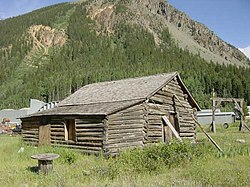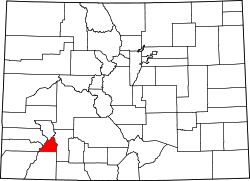Howardsville | |
|---|---|
 The Pride of the West Mill in Howardsville in 2018 | |
| Coordinates: 37°50′08″N107°35′39″W / 37.83556°N 107.59417°W | |
| Country | United States |
| State | Colorado |
| County | San Juan |
| Elevation | 9,748 ft (2,971 m) |
| Time zone | UTC-7 (Mountain (MST)) |
| • Summer (DST) | UTC-6 (MDT) |
| GNIS feature ID | 187646 [1] |
Howardsville is an unincorporated community in San Juan County, Colorado, United States, [1] along the Animas River at the mouth of Cunningham Creek. It is located about two miles from the town of Silverton and 8 miles from the famous ghost town of Animas Forks, and is on the same road as the ghost towns of Middleton and Eureka.



